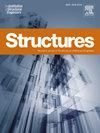粉煤灰对渣基工程地聚合物复合材料的影响:多尺度研究
IF 4.3
2区 工程技术
Q1 ENGINEERING, CIVIL
引用次数: 0
摘要
本文研究了不同粉煤灰掺量对渣基工程地聚合物复合材料(EGC)的影响。进行了单纤维拉拔、单裂纹拉伸和狗骨试件拉伸试验,进行了多尺度研究。结果表明,粉煤灰掺量从20% %增加到40% %时,抗拉强度、抗压强度、抗弯强度和抗拉应变能力分别提高15 %、32 %、34 %和319 %。当粉煤灰掺量从20 %增加到40 %时,最大桥接应力从1.5 MPa增加到3.72 MPa,使EGC的拉伸应变能力达到12.6 %。当粉煤灰掺量为50% %时,EGC的力学性能开始恶化。研究表明,不同的地聚合物产品与聚乙烯纤维的界面性能不同。SEM-EDS和XRD结果表明,地聚合物基体中的低钙相比高钙相具有更大的实际接触面积。此外,EGC由渣基向粉煤灰基转变过程中还存在化学键结。粉煤灰对渣基EGC的影响是显著的,因为它通过改变基质的化学和物理性质来改变纤维和基质的界面性质。本文章由计算机程序翻译,如有差异,请以英文原文为准。
Impact of fly ash on slag-based engineered geopolymer composites: Multiple-scale investigations
This study investigates the impact of varying fly ash dosages on slag-based engineered geopolymer composites (EGC). The single-fibre pull-out, single-crack tensile, and dog-bone specimen tensile tests were carried out for the multiple-scale investigations. Results indicate that increasing the fly ash dosage from 20 % to 40 % enhanced the tensile strength, compressive strength, flexural strength, and tensile strain capacities by 150 %, 32 %, 34 %, and 319 %, respectively. The maximum bridging stress increased from 1.5 MPa to 3.72 MPa as the fly ash content raised from 20 % to 40 %, resulting in a 12.6 % tensile strain capacity in EGC. However, the mechanical performance of EGC started to deteriorate when using 50 % of fly ash. This study revealed that different geopolymer products exhibited varying interfacial properties with polyethylene fibre. According to the SEM-EDS and XRD results, low-calcium phase in geopolymer matrix provide a larger real contact area compared to high-calcium phases. Additionally, chemical bonding existed as the EGC transformed from being slag-based to fly ash-based. The impact of fly ash on slag-based EGC is significant, as it changes the interfacial properties of fibre and matrix by changing the chemical and physical properties of matrix.
求助全文
通过发布文献求助,成功后即可免费获取论文全文。
去求助
来源期刊

Structures
Engineering-Architecture
CiteScore
5.70
自引率
17.10%
发文量
1187
期刊介绍:
Structures aims to publish internationally-leading research across the full breadth of structural engineering. Papers for Structures are particularly welcome in which high-quality research will benefit from wide readership of academics and practitioners such that not only high citation rates but also tangible industrial-related pathways to impact are achieved.
 求助内容:
求助内容: 应助结果提醒方式:
应助结果提醒方式:


